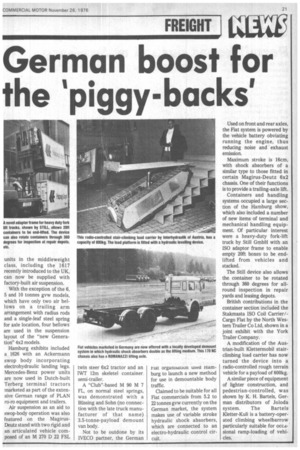Permit hopes dashed at Hamburg
Page 22

Page 23

If you've noticed an error in this article please click here to report it so we can fix it.
THE FUTURE expansion of international road freight movements to and from Germany will have to be met by special quota allocations linked to the use of rail-carrier facilities.
This was stated categorically by Heinz Ruhnau, Permanent Secretary to the German Ministry of Transport, at Last week's opening of the Hamburg Transport Exhibition — TM '76.
In dashing hopes for an increase in permit allocations for countries with bilateral road transport agreements, Ruhnau said that German policy strongly favours the development of international piggy-back services such as those already projecting into Holland (Rotterdam) and Yugoslavia.
In view of this official statement, it was somewhat puzzling that there was no direct participation by the Kombiverkehr organisation (German piggy-back operators) in this show, which otherwise was strongly road-haulage oriented.
Introduction by DaimlerBenzat Hamburg, of air suspension for a number of models now completes a programme which began in 1974, when certain of the maximum weight rigids and tractors became available with an airspring option.
Primarily intended for swop body and container operation — in which the suspension units provide the necessary vertical travel for picking-up and setting-down — the Mercedes-Benz range now extends to the lighter weight 608 and 808 chassis for gross weights of 6,500kg and 7,500kg respectively.
Air suspension is not used for the front axle as the proprietory sub-frame lifts available for demount applications can provide the required movement at the front end of the body.
In addition to the 608 and 808 models already mentioned, seven rigid and five tractive units in the middleweight class, including the 1617 recently introduced to the UK, can now be supplied with factory-built air suspension.
With the exception of the 6, 5 and 10 tonnes gvw models, which have only two air bellows on a trailing arm arrangement with radius rods and a single-leaf steel spring for axle location, four bellows are used in the suspension layout of the "new Generation" 4x2 models.
Hamburg exhibits included a 1626 with an Ackermann swop body incorporating electrohydraulic landing legs. Mercedes-Benz power units are now used in Dutch-built Terberg terminal tractors marketed as part of the extensive German range of PLAN ro-ro equipment and trailers.
Air suspension as an aid to swop-body operation was also featured on the MagirusDeutz stand with two rigid and an articulated vehicle composed of an M 270 D 22 FSL twin steer 6x2 tractor and an iwr 12m skeletel container. semi-trailer.
A "Club"-based M 90 M 7 FL, on normal steel springs, was demonstrated with a Bussing and Sohn (no connection with the late truck manufacturer of that name) 3.5-tonne-payload demount van body.
Not to be outdone by its 1VECO partner, the German Fiat organisation used Hamburg to launch a new method for use in demountable body traffic.
Claimed to be suitable for all Fiat commercials from 5.2 to 22 tonnes gvw currently on the German market, the system makes use of variable stroke hydraulic shock absorbers, which are connected to an electro-hydraulic control circuit. Used on front and rear axles, the Fiat system is powered by the vehicle battery obviating running the engine, thus reducing noise and exhaust emission.
Maximum stroke is 16cm, with shock absorbers of a similar type to those fitted in certain Magirus-Deutz 6x2 chassis. One of their functions is to provide a trailing-axle lift.
Containers and handling systems occupied a large section of the Hamburg show, which also included a number of new items of terminal and mechanical handling equipment. Of particular interest were a heavy-duty fork-lift truck by Still GmbH with an ISO adaptor frame to enable empty 2Oft boxes to be endlifted from vehicles and stacked.
The Still device also allows the. container to be rotated through 360 degrees for allround inspection in repair yards and leasing depots.
British contributions in the container section included the Stakmasta ISO Coil Carrier/Cargo Flat by the North Western Trailer Co Ltd, shown in a joint exhibit with the York Trailer Company.
A modification of the Austrian-built Klettermobil stairclimbing load carrier has now turned the device into a radio-controlled rough terrain vehicle for a payload of 800kg.
A similar piece of equipment of lighter construction, and pedestrian-controlled, was shown by K. H. Bartels, German distributors of Joloda system. The Bartels Kletter-Kuli is a battery-operated climbing wheelbarrow particularly suitable for occasional ramp-loading of vehicles.








































































































